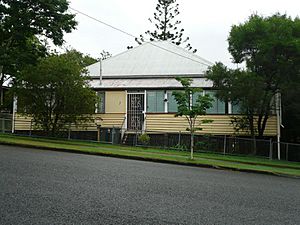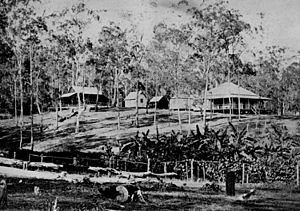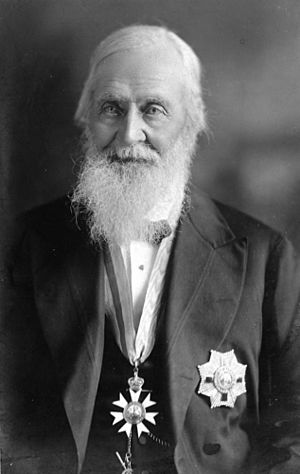Rainworth House, Bardon facts for kids
Quick facts for kids Rainworth House, Bardon |
|
|---|---|

Rainworth House, 2009
|
|
| Location | 7 Barton Street, Bardon, City of Brisbane, Queensland, Australia |
| Design period | 1840s - 1860s (mid-19th century) |
| Built | c. 1862 |
| Built for | Augustus Charles Gregory |
| Architect | Augustus Charles Gregory |
| Official name: Rainworth | |
| Type | state heritage (built) |
| Designated | 21 October 1992 |
| Reference no. | 600282 |
| Significant period | 1860s (fabric) 1860s-1905 (historical) |
| Significant components | residential accommodation - main house |
| Builders | Augustus Charles Gregory |
| Lua error in Module:Location_map at line 420: attempt to index field 'wikibase' (a nil value). | |
Rainworth is a special old house in Bardon, Queensland, Australia. It was built around 1862. This house is so important that it's listed on the Queensland Heritage Register. This means it's protected because of its history. The house even gave its name to the area around it, which used to be called Rainworth.
Contents
The Story of Rainworth House
Rainworth House was built by Sir Augustus Charles Gregory. He was a famous explorer and a very important person in Queensland's early days. From 1859 to 1879, he was the surveyor-general of Queensland. This job meant he was in charge of mapping the land.
Sir Gregory lived in Rainworth House from 1862 until he passed away in 1905. People say he built the house himself. He was also a strong voice in the Queensland government. He was a Member of the Queensland Legislative Council. This was a group of people who helped make laws for the state.
Gregory was also a leader in the local council and a well-known scientist. Rainworth House was his quiet place. It was where he could think, invent new things, and write.
After Sir Gregory, the house was rented out by different owners. One owner was Robert Philp, who was a merchant and a politician. Later, in 1949, Frederick and Mildred Howell rented the house. They eventually bought it, and their family still lives there today.
What Rainworth House Looks Like
Rainworth is a unique house with a short, steep roof. It has verandahs, which are like covered porches, on three sides. The front of the house has three sets of French doors. These are doors that open wide, often with glass panels. There is also one French door on the left side.
Old photos show that the back parts of the side verandahs were closed in. This created extra rooms or enclosed spaces.
Most of the outside walls are made of thick wooden boards. Inside, the walls are lined with wooden boards that fit together. The ceilings are also high and made of wood. To help air move through the house, there are special windows above the French doors. These windows can be opened easily with small wooden knobs.
Why Rainworth House is Important
Rainworth House was added to the Queensland Heritage Register in 1992. This means it's recognized as a very important historical place. Here's why:
A Glimpse into Queensland's Past
Rainworth is a rare example of a house built in the 1860s. It shows how homes were designed back then. It started as a farmhouse in the countryside. Now, it's part of a busy suburb in Brisbane. This shows how Queensland has grown and changed over time.
Sir A.C. Gregory's Legacy
The house is very important because of its strong connection to Sir A.C. Gregory. It still feels like the home of a practical explorer, not just a famous public figure. Sir Gregory's importance is remembered in many places. For example, there's Gregory Street in Toowong and Gregory Park in Milton. Even the area of Rainworth itself is named after the house.




